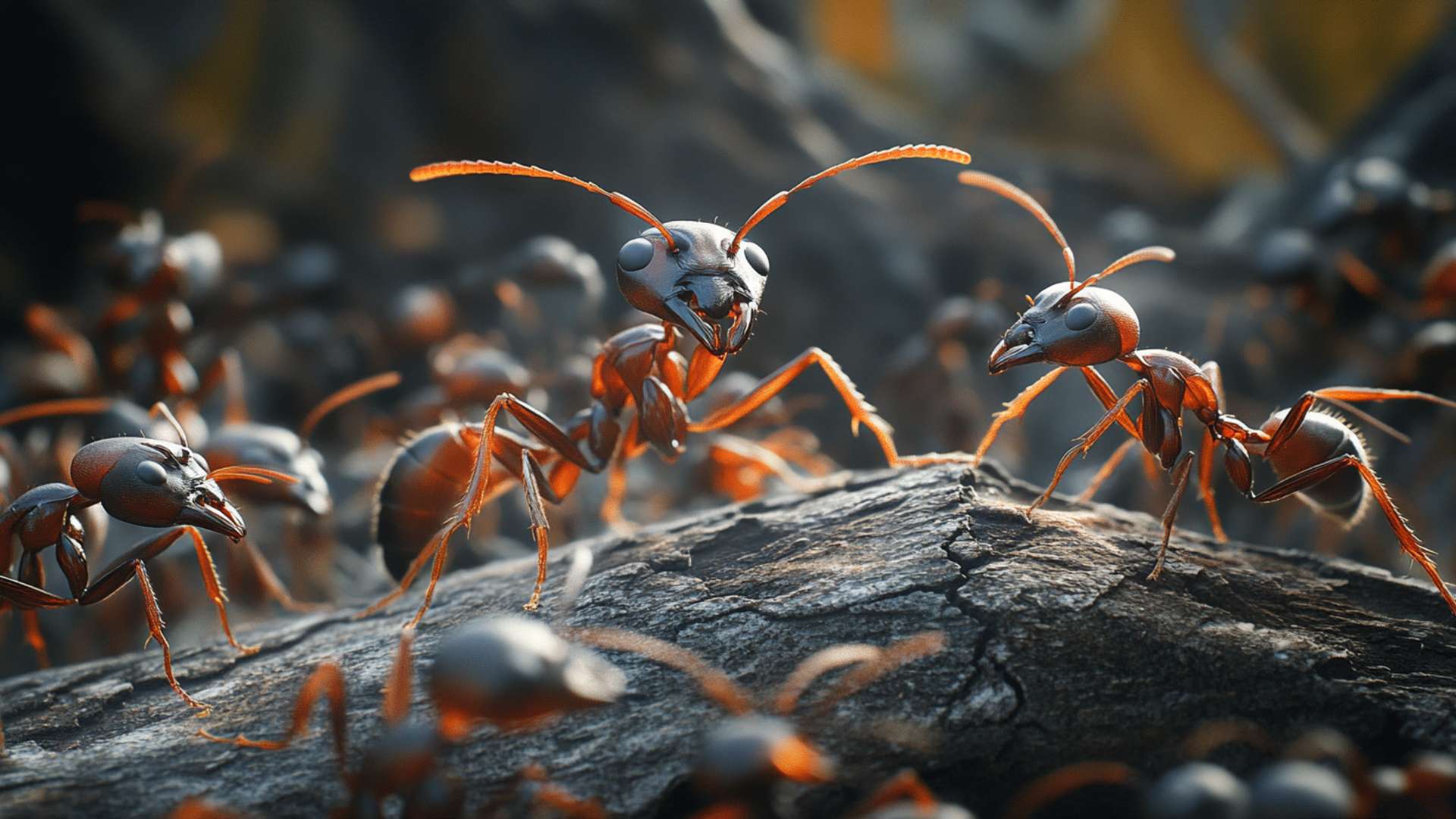When we think of ants, we often envision these tiny insects scurrying around in search of food. However, what many people fail to realize is that ants possess a strength that defies their small size. These minuscule creatures have an astonishing ability to carry objects that are multiple times heavier than themselves.
It’s truly remarkable! Just imagine a creature the size of a grain of rice effortlessly hauling items much larger and heavier than them.
Ants have captivated scientists and researchers for centuries due to their exceptional strength-to-size ratio. These industrious insects can lift objects weighing up to 50 times their own body weight.
To put this into perspective, imagine yourself lifting not just one, but several cars at once! This extraordinary feat has puzzled experts for years.
How do ants manage such incredible feats of strength? Well, it turns out they owe their power to fascinating biological adaptations that enable them to achieve these Herculean tasks.
Importance of understanding ant strength for various purposes
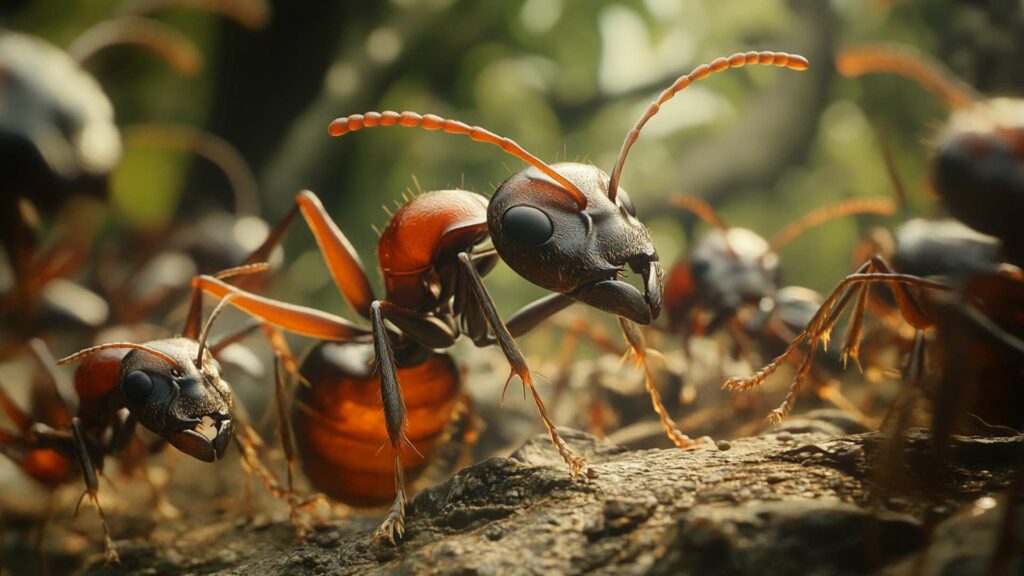
Understanding the true extent of ant strength is crucial for numerous reasons. Firstly, gaining insight into the mechanics behind their extraordinary lifting abilities can provide us with valuable knowledge about material science and engineering principles.
By studying how ants distribute loads and manage large stress concentrations on their bodies while carrying comparatively heavy loads, scientists can draw inspiration from nature’s designs when developing new materials or designing structures capable of withstanding extreme stresses. Moreover, comprehending ant strength has practical implications beyond scientific curiosity.
Industries such as robotics and manufacturing can benefit enormously from emulating the strategies employed by ants when it comes to moving heavy objects efficiently. By studying how ants coordinate tasks using chemical signals (pheromones), we may uncover new ways to enhance communication systems in technological applications.
Delving into the realm of ant strength not only satisfies our curiosity about the natural world but also opens up possibilities for technological advancements. By uncovering the secrets behind their tremendous power, we can learn from these tiny creatures and potentially revolutionize industries that rely on concerted strength and efficient communication systems.
General Strength of Ants

Ants may be small, but don’t let their size fool you! These industrious insects possess an incredible strength-to-size ratio that is truly astounding.
Imagine a creature weighing just a fraction of a gram being able to carry objects many times its own body weight. This remarkable feat is possible due to the unique structure and mechanics of an ant’s body.
You see, ants have evolved over millions of years to become miniature powerhouses. Their exoskeleton, which acts as both their skeleton and protective armor, allows them to efficiently distribute stress across their bodies.
Unlike our internal skeletal structure, the exoskeleton covers the entire surface area of an ant’s body, providing the ant bodies excellent support for its muscles and organs. This structural advantage enables ants to generate greater force while carrying loads compared to organisms without an exoskeleton.
Now let’s dive into the mind-boggling question: how do ants manage to carry objects that are several times heavier than themselves? Well, it all comes down to physics and some clever adaptations.
Ants possess powerful muscles relative to their size, allowing them to generate impressive amounts of force. But what truly sets them apart is their ability to leverage mechanical advantages effortlessly.
When carrying heavy loads such as food or building materials for their nests, ants position themselves in a way that reduces the load’s distance from their center of gravity. This favorable positioning increases stability and minimizes torque—a concept similar to what you experience when trying to lift something heavy with your arms extended versus holding it closer to your body.
Moreover, ants utilize frictional forces effectively by grasping objects using specialized structures like mandibles or hooks on their legs. This ensures a secure grip and prevents slippage.
It’s like they have their own built-in grip-enhancing technology! By combining their muscle strength, mechanical leverage, and frictional prowess, ants are able to carry objects that seem utterly unthinkable considering their diminutive stature.
Comparison Between Ant Strength and Human Strength, Highlighting the Relative Power of Ants
To truly appreciate the extraordinary strength of ants, let’s put it into perspective by the ants body weight and comparing it to our own human capabilities. An average field ant can typically carry objects weighing around 10-50 times its body weight.
This means that if humans had similar strength-to-size ratios, an average person would be able to lift cars or even small elephants without breaking a sweat! Quite a staggering thought, isn’t it?
In fact, researchers at Ohio State University conducted studies using scaled-up models of ants on a human-sized scale. The results were mind-blowing-they found that if we could replicate an ant’s muscle strength and exoskeleton structure on a human-scale, we could potentially create autonomous devices capable of lifting massive loads effortlessly.
So the next time you witness ants working tirelessly in unison to transport comparatively heavy loads or construct intricate nests underground, take a moment to marvel at their impressive mechanical systems. These tiny creatures possess strength far beyond what you might expect from their size and prove that size truly doesn’t define power in the natural world.
Factors Influencing Ant Strength
When it comes to ant strength, not all species of particular ant are created equal. Just like humans, ants come in a wide variety of shapes and sizes, each with its own unique level of strength.
Some species, such as leafcutter ants, have been known to carry comparatively heavy loads that are many times their own body weight. These industrious creatures have incredibly strong jaws that allow them to slice through leaves effortlessly and transport these leafy burdens back to their nests.
On the other end of the spectrum, we have smaller ant species that may not possess the same raw power as their larger counterparts. However, what they lack in size they certainly make up for in agility and resourcefulness.
These tiny warriors are capable of navigating through narrow crevices and tight spaces with ease. Their small size enables them to forage for food in areas that would be inaccessible to larger ants.
Explanation of how an ant’s size affects its overall physical power
Size matters when it comes to determining an ant’s overall physical power. Generally speaking, larger ants tend to be stronger than their smaller counterparts due to a few key factors. Firstly, a bigger body means there is more room for muscles which can generate greater force.
Additionally, a larger body enables an ant to have a stronger exoskeleton – the hard outer shell that provides protection and structural support. The exoskeleton plays a crucial role in an ant’s weight-lifting ability because it serves as a solid anchor point for muscles while lifting objects off the ground.
In contrast, smaller ants have softer exoskeletons with less surface area for muscle attachment points. Consequently, they may struggle when it comes to carrying extreme loads compared to their larger relatives.
Insight into the role of nutrition and diet in determining ant strength
It may surprise you to learn that an ant’s strength is not solely dependent on its size or species. Nutrition and diet play a vital role in determining the overall physical power of these tiny creatures.
Just like athletes require proper nutrition to perform at their best, ants need a balanced diet to maximize their strength. A study conducted by entomologists found that protein-rich diets significantly increase an ant’s muscle strength.
This makes intuitive sense, as protein is essential for muscle development and repair. Ants that have access to abundant food sources containing high levels of protein tend to exhibit greater physical prowess than those with limited dietary options.
Furthermore, the availability of carbohydrates also impacts an ant’s energy levels and overall strength. Carbs provide ants with the necessary fuel for their demanding activities, allowing them to sustain prolonged periods of strenuous work.
Understanding how factors such as species diversity, size, and dietary habits influence ant strength gives us valuable insights into the fascinating world of these industrious insects. Whether it’s the giant robot ants we often see in science fiction or micro-sized robots inspired by real-life ants, studying these tiny powerhouses could potentially enable future robots to perform feats once only imaginable on a more human sized ant-sized scale.
Specialized Adaptations for Enhanced Strength in Ants
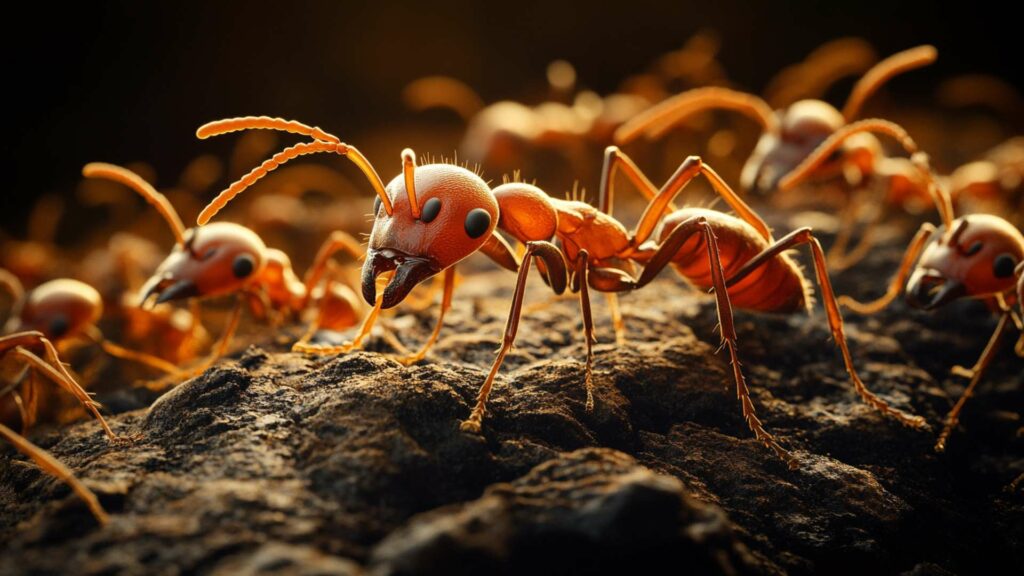
When it comes to their tiny size, ants possess some remarkable anatomical features that give them impressive strength. One key factor contributing to their strength is their mighty mandibles.
These are the ant’s jaws, which are specially designed to exert significant force. The mandibles of different ant species can vary in shape and size, but they all serve the same purpose – allowing ants to bite or grasp objects with incredible strength.
Moreover, ants have powerful muscles that enable them to utilize their mandibles effectively. These muscles are located near the neck joint at the head-neck-chest joint known as the pronotum.
This connection allows ants to generate force with precision and efficiency when using their mandibles for various tasks such as carrying food or defending their colonies. The combination of strong mandibles and well-developed musculature allows even the tiniest ants to perform astonishing feats relative to their small size.
Examination of how certain ant species have evolved specialized structures to increase their lifting capacity or biting force
In addition to general anatomical features, certain ant species have evolved specialized structures that further enhance their lifting capacity or biting force. For instance, some larger ant species possess a graded and gradual transition between hard and soft parts within specific segments of their bodies.
This design redistributes forces more evenly during heavy lifting tasks. Researchers have used micro CT scans combined with computer simulations to study these specialized structures in detail.
They observed that these transitions minimize stress concentration within the ant’s body while the ant carries loads many times greater than its own weight. By distributing forces in this manner, ants can withstand extreme loads without causing damage or injury.
Interestingly, scientists have drawn inspiration from these micro-scale structures found in ants when designing large robots. By replicating the gradual transitions between hard and soft parts, engineers have been able to create robots that can carry heavy loads while minimizing stress and potential damage.
These robots behave mechanically similarly to ants, utilizing the same principles of weight distribution and force management. Ants’ specialized anatomical features, such as strong mandibles and well-developed musculature, contribute significantly to their impressive strength.
Furthermore, certain ant species have evolved unique structures that enhance their lifting capacity or biting force. Understanding these adaptations not only sheds light on the remarkable abilities of ants but also inspires scientists in the development of future robotic technologies capable of performing tasks under extreme loads with efficiency and minimal damage.
Impressive Feats Demonstrating Ant Strength

Ants may be small, but they possess an incredible ability to work together and achieve remarkable feats of strength. One awe-inspiring example is their ability to collectively move large objects.
Picture this: a team of ants working tirelessly to transport food or building materials many times their own body weight. How do they manage such Herculean tasks?
Well, it all comes down to teamwork and strategic coordination. In the animal kingdom, ants are renowned for their exceptional organizational skills.
When faced with an obstacle or a sizeable object, they employ a remarkable strategy called “daisy chaining.” They form long chains by interlocking their legs and mandibles, creating a solid structure that allows them to distribute the load evenly. This cooperative effort not only enables them to move objects much larger than themselves but also showcases their impressive strength-to-size ratio.
Ants are not just industrious builders; they are also fierce warriors when it comes to protecting their colonies or obtaining resources. Despite their small stature, ants have been known to overpower larger insects or prey through sheer force.
Their determination combined with incredible physical capabilities make them formidable adversaries. Consider encounters between ants and other insects several times their average body weight alone.
Whether it’s battling rival ant colonies or subduing unsuspecting prey like crickets or grasshoppers, ants exhibit astounding strength in such confrontations. Through coordinated attacks using venomous stingers or powerful jaws, they strategically exploit weak points in the exoskeletons of larger foes.
This display of tenacity and force highlights just how potent these tiny creatures can be. Ants demonstrate impressive feats of strength both through collective efforts like moving large objects and in individual battles against larger creatures.
Their ability to coordinate and work together, combined with their physical adaptations, enables them to achieve tasks that seem inconceivable given their size. So, the next time you see an ant bustling about its business, take a moment to appreciate the hidden power behind its minuscule form.
The Role of Communication in Harnessing Collective Ant Strength
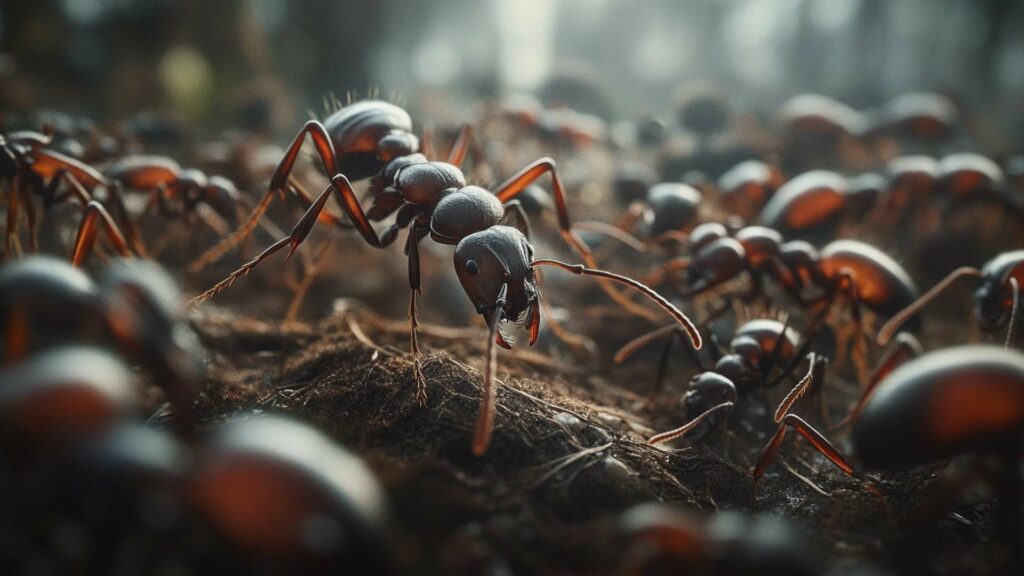
Ants are highly social insects that rely on effective coordination and communication within their colonies to achieve remarkable feats of strength. Individual ants may be small, but when they work together, their combined power becomes exponentially greater.
Through complex chemical signals and intricate behavioral patterns, ants are able to organize themselves into efficient units that can accomplish tasks requiring significant force. Ant colonies operate as cohesive units, with each ant having a specific role within the larger system.
For example, when faced with the challenge of moving a large food source back to the nest, worker ants communicate with each other to synchronize their efforts. They use pheromones as chemical signals to mark trails for others to follow, guiding them towards the desired location.
This enables ants to navigate complex terrains while coordinating their movements effectively. By working together in this manner, ants can mobilize an army of workers who act in unison to achieve a common goal.
Description of pheromones and chemical signals used by ants to organize tasks requiring significant force
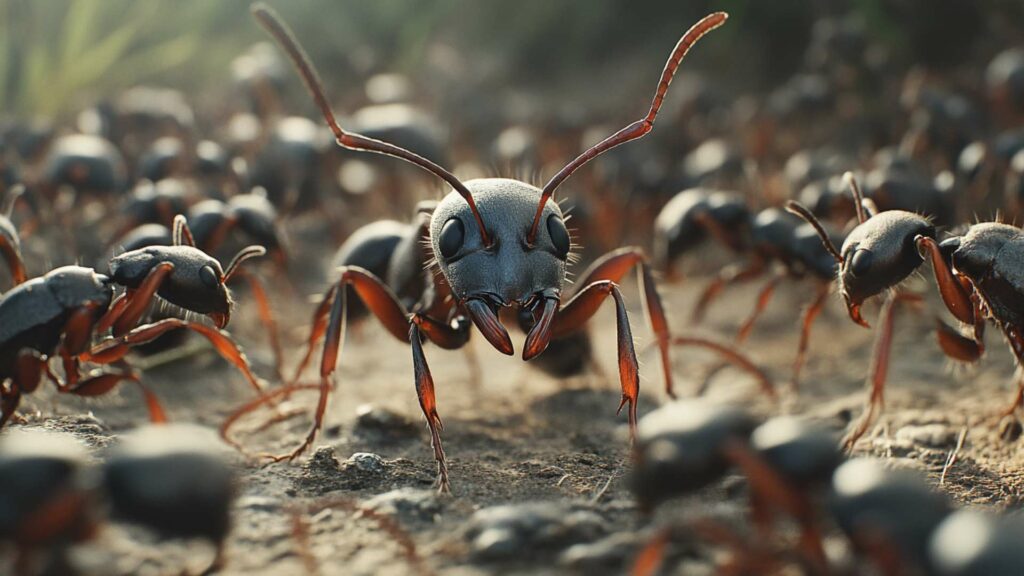
Pheromones play a crucial role in ant communication and organization. These chemical signals are released by individual ants and detected by others through specialized receptors located primarily on their antennae.
Pheromones convey important information such as trail marking, detecting danger, or locating food sources. When it comes to organizing tasks requiring significant force, such as lifting heavy objects or constructing elaborate nests underground, ants use pheromones strategically.
For instance, during a collective hauling effort known as “group recruitment,” worker ants release trail pheromones along the path from the object being moved back towards the nest. As more workers detect these pheromone trails using their antennae, they join in hauling the load together.
By following these chemical trails, ants effectively communicate the need for additional manpower and direct their fellow workers towards the task at hand. This coordinated response allows ants to pool their strength and achieve astonishing feats that would be impossible for an individual ant alone.
Unusual Facts about Ant Strength
While ants, in general, possess impressive strength relative to their size, there are certain species that stand out even among their tiny peers. For instance, the Asian weaver ant (Oecophylla smaragdina) has been observed carrying loads up to 100 times its own weight.
These remarkable creatures have specialized leg adaptations that enable them to grasp objects tightly while maintaining a secure grip. Another fascinating species is the bullet ant (Paraponera clavata), famous for having one of the most painful stings in the insect world.
Despite being relatively small, these ants boast incredible physical power. They are known to immobilize larger prey or defend their colonies using powerful mandibles capable of delivering a bite force equivalent to three times their body weight.
The remarkable strength demonstrated by ants has not gone unnoticed by scientists and engineers. Researchers in fields such as mechanical and aerospace engineering have sought inspiration from ant’s bodies’ ability to carry comparatively heavy loads and navigate challenging environments.
By studying the biomechanics of ant movement and dissecting it on a microscopic level using techniques like micro computed tomography (micro CT scans), scientists have gained insights into optimizing mechanical functions in various applications. One particularly interesting study involved mimicking an ant’s body structure to develop new types of soft materials that can bear extreme loads without collapsing.
By replicating how ants distribute stress across their bodies through careful analysis of micro CT scans, researchers were able to design materials with enhanced load-bearing capabilities. This research has potential applications in fields ranging from robotics to architecture, where the ability to withstand heavy forces while maintaining flexibility and resilience is crucial.
Conclusion
Ants possess extraordinary strength that far exceeds their minuscule size. Through effective coordination and communication, ants are able to harness their collective power and achieve feats that seem almost impossible for individuals alone.
The use of pheromones and chemical signals allows ants to organize tasks requiring significant force, enabling them to work together seamlessly. Furthermore, specific ant species exhibit remarkable physical abilities that continue to inspire scientific research in various fields.
By studying the mechanics of ant movement and exploring the potential applications of their strength in engineering contexts, scientists are unlocking new possibilities for optimized mechanical function. The world of ants serves as a reminder that strength comes in many forms, and sometimes the most impressive feats are achieved through collaboration and unity.
Just as ants leverage their collective power to carry loads many times their own weight, we too can accomplish great things when we work together towards common goals. So let us embrace the lessons from these tiny creatures and remember that even in our individual lives, collaboration and effective communication can lead us to surpass our own expectations.
Dissuade Ants with D-Termination: Las Vegas’ Top Pest Control Choice!

If you’re experiencing ant problems, D-Termination is here to provide assistance. Our skilled team specializes in deterring ants, revitalizing cleanliness, and preserving the integrity of your area. Bid farewell to ants—opt for D-Termination for highly effective pest control today!
Contact us at 702-919-6310 or visit dtermination.com to schedule your ant control service and reclaim your space from these unwanted pests.
Frequently Asked Questions:
Ants are relatively strong for their size but not exceptionally strong compared to larger animals.
Ants can carry objects many times their own weight, but the limit varies by species.
If humans had the strength of ants, they could potentially lift objects far heavier than they can currently.
Among insects, ants are often considered some of the strongest due to their ability to carry heavy loads relative to their size.

